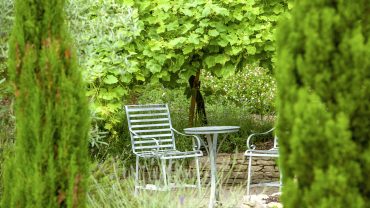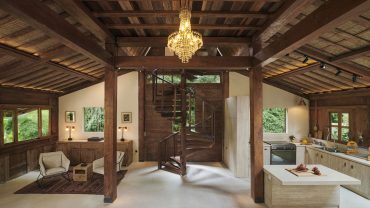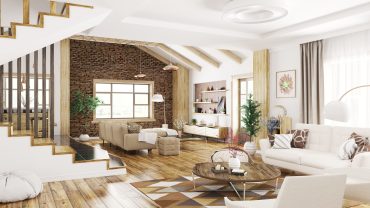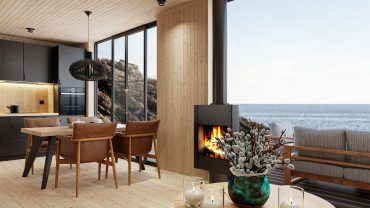It’s been said that a clear desk makes for a clear mind. And nowhere is that more relevant than in the home office. As remote work becomes the norm and our professional lives blend with personal space, creating an environment that fosters focus without the fuss is more essential than ever. Enter minimalist home office design.
With its crisp lines, clutter-free surfaces, and purpose-driven pieces, this approach is all about creating a serene, streamlined space where productivity can flourish. Think neutral palettes, natural light, and layouts which prioritise calm over chaos. Want to know how this works in practice? Read on as we drill down into minimalist home office ideas that are simply the ‘desk.’
The Workings of Minimalist Design

A visually stunning modern home office (Credit: Ramilaliyev via Getty Images)
Before brainstorming specific minimalist home office ideas, it helps to understand the principles that underpin this design philosophy. At its core, minimalist interior design emphasises practicality, visual simplicity, and intentionality.
The spaces created under this approach feel clear and open, enhanced by natural light and framed with a neutral palette. Every item present serves a purpose. Surfaces are kept free from visual clutter, furniture is streamlined and functional, and decoration is used sparingly but effectively. In short, the entire space is designed to calm the mind and support function.
When these concepts are applied to a home workspace, the result is a minimalist home office setup that promotes clarity and focus.
Up the Wall Organisation

The flexibility and functionality of vertical storage (Credit: ismagilov via Getty Images)
A clutter-free desk is a minimalist must. Still, there are some things that are best kept close at hand. We’re talking pens, paperclips, and post-its. The solution? Think vertically. That’s right; instead of crowding the table surface with bits and pieces, a wall mounted system keeps them in sight yet nice and neat. Pegboards are a great option for this. With their Scandi simplicity and myriad attachment options, they offer flexibility and functionality in equal measure. But the true minimalist magic is in curating their configuration to transform them into an elegant form of minimalist study decor. A carefully spaced selection of pots, shelves, or hooks, perhaps a small succulent added to the mix, and the result is as artful as it is useful.
Concealed Cupboards

Concealed cupboards in a minimalist home office (Credit: Boris SV via Getty Images)
Vertical organisation helps, but minimalist home office ideas must also accommodate the bulkier components of work life. From files and folders to printer paper and spare toner, there’s a seemingly endless array of necessary “stuff” that needs to go behind closed doors. In a well designed minimalist office, these would ideally be sleek, handleless doors for that uninterrupted visual flow. Built-in cupboards offer the ultimate option to create a seamless look. But where bespoke is beyond the budget, modular furniture can be styled to appear custom built. The result? Clear surfaces, clean lines, and a calm place to work.
Neutral Tones

A neutral colour palette in a home office (Credit: ismagilov via Getty Images)
Neutral tones align perfectly with the light and airy minimal study interior aesthetic. Not only do pale shades such as white, beige, and soft grey form a soothing backdrop, but they allow natural light to bounce around, making the space feel bigger. The key is to commit to the colour scheme. From the chair to the desk, the walls to the floors, a consistent approach maximises the seamless feel. Things get a bit trickier when it comes to the tech. Components like keyboards, mice, and monitors tend to be black or metallic, but disrupt the overall look. Seeking out those in lighter shades may seem trivial, but it makes a big difference.
Cord Control

Tidy tech (Credit: ismagilov via Getty Images)
And, speaking of tech, cables, chargers, and monitors have a curious way of multiplying. Before long, even the most refined home office can become a tangled web. In minimalist design, the aim is to integrate these necessities so seamlessly they almost disappear. The good news is, there are lots of ways to do this, including cable routing holes built into desks, wireless keyboards and mice to reduce clutter, discreet docking stations tucked into drawers, among other clandestine cleverness. Put together, these small adjustments can have a powerful impact. Surfaces stay pristine, focus stays sharp, and the overall space feels lighter and more intentional.
Let There Be Layered Lighting

Layered lighting in a contemporary home office (Credit: onurdongel via Getty Images)
Lighting is a foundational element of minimalist home office design. It affects both the atmosphere and the usability of the space. A layered approach works best: ambient overhead lights create an even base, while task lighting ensures key areas are well illuminated. Accent lights add softness and highlight architectural features or textures. The idea is to create flexibility throughout the day and to allow the room to shift seamlessly from morning meetings to evening emails.
Fixtures should blend into the background – recessed LEDs, slimline lamps, or under-shelf lighting all support the look without becoming a distraction. In doing so, they underscore the aesthetic of a minimal study interior.
Flexible Working

Modular desks can be rearranged easily and stylishly (Credit: Westend61 via Getty Images)
In a minimalist office design, every square foot matters. Expandable furniture, with its clever adaptability, manages to tick all the right boxes: it maximises floor space, preserves visual calm, and plays beautifully into the pared-back ethos of minimalist living.
Think drop-leaf desks that tuck away neatly after hours, wall-mounted consoles that slide open when it’s time to focus, or nesting tables that offer flexible surfaces without permanent bulk.
Moreover, expandable furniture champions the practical heart of minimalism. It provides exactly what’s needed, exactly when it’s needed – no more, no less. There’s a quiet satisfaction in a table that unfolds only for meetings, or a shelving unit that expands when your book collection grows, then discreetly contracts again. This subtle, seamless shift from form to function reflects the core of minimalist design: letting utility guide beauty.
Hide and Chic

A concealed workspace (Credit: Elena Grigorovich via Getty Images)
So far, we’ve looked at hiding individual elements of minimalist study decor – cables, storage, tech. But what about the entire home office? In rooms with multiple functions, such as guest bedrooms or open-plan living areas, the entire home office can be designed to vanish. A wall cabinet with pivot-sliding doors allows a workspace to tuck away seamlessly, leaving behind a smooth, uninterrupted façade. When open, the doors slide discreetly into the sides of the unit, preserving flow and avoiding visual bulk.
In guest rooms, a murphy bed can fold away to reveal a workstation, for smart dual-purpose design without adding clutter. This level of concealment supports both the aesthetic and the comfort of the space – removing reminders of work when not needed, and restoring a sense of calm. It’s a refined solution that embodies minimalist thinking at its purest: beautiful, functional, and perfectly in balance.
Feel-Good Finishes

Subtle and stylish (Credit: ismagilov via Getty Images)
With its aversion to clutter and fussy details, minimalist design often relies on texture to bring depth and warmth without compromising visual simplicity. The best part is, nothing new needs to be added. It’s just about incorporating it into the furniture and items already there. Rather than introducing superfluous layers or decorative detail, texture is woven into the essentials – allowing each piece to serve more than one purpose. This quiet layering adds comfort and character while aligning with the minimalist ideal of using only what is needed.
For instance a boucle fabric can make an office chair cosy and soft, a felt desk pad can add a cushioning with textural interest while protecting surfaces, and a plush rug offers comfort underfoot. Each element earns its place, not only by function but through the subtle richness it brings.
Streamlined Seating

A minimalist yet inviting space (Credit: Westend61 via Getty Images)
Minimal study interiors rely on simplicity to create a calm and organised feel. Furniture selected for these spaces tends to feature clean, sleek lines without unnecessary details. Floating desks, slim tables, and streamlined shelves enhance openness and prevent visual clutter. For example, desks crafted from pale oak with slim metal legs provide functionality without overwhelming the room. Shelving with open structures, often in soft shades like white or grey, also helps maintain a fresh and uncluttered appearance.
Office chairs suited to minimalist designs follow similar principles. Such chairs usually have understated forms and smooth contours. Commonly made from natural materials like wood or soft fabric upholstery, these chairs come in neutral or pastel shades, including beige, soft grey, or gentle blues. Their simplicity complements a clean, modern office, adding warmth without dominating the visual space.
Whitespace for the Win

Less is more (Credit: Westend61 via Getty Images)
Finally, what’s not in the room is just as important as what is. It’s essential to the minimalist aesthetic to allow breathing room between items, leave corners untouched, and avoid the temptation to fill every wall.
This use of negative space – open floor, unadorned shelves, clean desktops – keeps energy flowing and distractions low. It’s the final, essential principle of minimalist office design.
The Bottom Line: Less is More

Focus, creativity and calm (Credit: snorkulencija via Getty Images)
As we’ve seen, minimalist home office design is about curating a space which supports focus, creativity, and calm. Through intentional layouts, hidden storage, and serene styling, every element of minimalist study decor contributes to a more centred, productive atmosphere.












